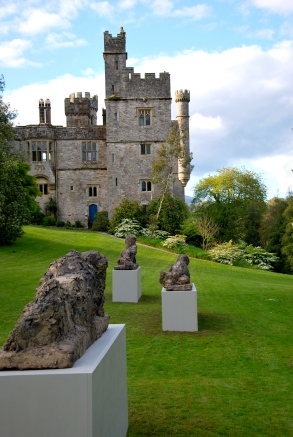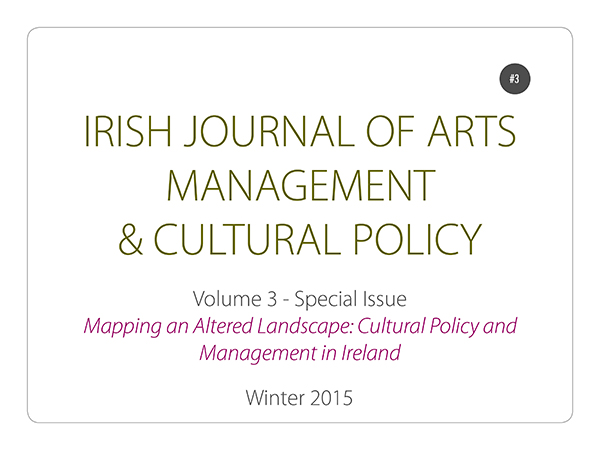
Hans Josephsohn exhibition at Lismore Castle Arts
It’s been extraordinarily busy policy-wise in the arts the last few weeks — this update will be a long one — I’ll do my best to provide a summary! (p.s. if I’ve gotten anything wrong here, please do write in & correct me! Or feel free to add your impressions/responses in the comments…)
The second meeting of the Visual Arts Workers’ Fourm (kindly hosted by the Glucksman Gallery, UCC) last Thursday 17 May proved a lively & interesting day. So much ground was covered, it’s impossible to do justice to it all — however I found most useful the presentations by Mary McCarthy (from the National Sculpture Factory) and Sarah Glennie (new director of IMMA) providing updates on the status of the Culture Ireland, National Campaign for the Arts and the amalgamations planned for the national cultural institutions. Here’s a breakdown of some of what was discussed (supplemented by a few recent developments):
- Culture Ireland: The expiration of Eugene Downes’ contract as Director is coinciding with a planned review of Culture Ireland; many in the audience voiced their support for the impact of CI’s contribution to the promotion of Irish culture, and praised Eugene’s contributions in particular. As yet there seems to be little public information on what exactly this review process will entail and when it will take place, with Mary reiterating the importance of remaining vigilant as to developments.
- National Campaign for the Arts: conversations around advocacy, developing stronger links with policymakers and politicians, and better articulating a collective vision for the purpose and importance of the arts were strong themes recurring throughout the day. Differences between VAI and VAWF were clarified (the former primarily devoted to the support of individual artists, the latter an as-yet loose grouping of the many organisations and individuals broadly included under the ‘visual arts’ banner, to include arts orgs, artists, curators, educators, etc.). Mary provided details of the NCFA’s working process and current status, urging folks to become involved (a very small number of people are making a large difference here), and reiterating the very significant impact its campaigns and outreach efforts have had to date. No consensus emerged out of the day as to how collectively the visual arts community might better organise — in more casual conversations with attendees I found views varied widely as to whether more formal organisation was needed, or whether a more organic approach was appropriate. I think most were in agreement, however, that meetings such as VAWF provided a valuable opportunity for information sharing, networking and getting a sense of the many diverse views and positions active in the visual arts community.
- National Cultural Institution amalgamation plans: Sarah spent a good deal of time discussing this, stressing that the proposals now on the table differ substantially in nature from those mooted in 2008, which garnered very strong opposition in the sector (voiced during a consultation held in IMMA)– plans that were later shelved. Very little has been made public about this process, so many in the audience were surprised to hear of the speed with which the re-vamped amalgamation plans are progressing — according to Glennie the decision to amalgamate in some form has been made by the Dept. of Public Expenditure and Reform, and is irreversible, with the window for working out the finer details (before a final decision by Cabinet) only about 6 weeks. The word since then is that the directors are collectively engaged in protecting the autonomy of each institution (especially in terms of curatorship and direction) to the greatest extent possible.There were very strong feelings in the audience about the importance of protecting the cultural institutions in a time of slash-and-burn approaches by civil servants with little knowledge of how these organisations actually function, and their already skeletal infrastructure. All of this has been given added momentum in the past few days with Diarmuid Ferriter’s announcement (more here too) he would be resigning from the board of the National Library in protest over the government’s ‘offensive and disingenuous double-speak’ around the cultural institutions (including but not limited to the amalgamation plans — which also have proposed merging the NLI, National Archives and the Manuscripts Commission). The amalgamation plans were further criticised yesterday by Senator Fiach Mac Conghail in the Senate session (here’s the full text of what was said). I believe all of this is extremely useful in highlighting how crucial these decisions are, and what their long-ranging impact will be on cultural institutions many of us take for granted. A lack of transparency over the terms of the proposals is worrying, and with such a short amount of time remaining to voice views on the subject, I hope developments will continue to be publicized widely (and I’ll try my best to do the same!)
Quite a number of folks approached me at VAWF to speak with me after I raised the issue of employment patterns (and specifically unpaid internships) in the arts… of further interest may be a recent report just published in the UK – Intern Culture – that has brought together a whole host of research and information on the current state of UK internships in the visual arts. It’s extremely useful and insightful, and well worth a read — I suspect we will soon reach a stage where more formalised inquiries and guidelines will have to be addressed here in Ireland as well.
Slightly buried in the story on the HEA funding crisis (which made the rounds in print and radio yesterday) was mention of ‘a review of third level creative arts and media courses in Dublin, including those at the National College of Art and Design, Dublin Institute of Technology and Dún Laoghaire Institute of Art, Design and Technology.’ I’ve heard some talk of this, with suggestions there may be plans afoot to rationalize/reduce programmes offered owing to ‘duplication’, but as of yet have heard nothing more concrete. One to keep an eye on…
Did you catch the conclusion of RTE’s ‘Masterpiece: Ireland’s Favourite Painting‘ last night? Not surprisingly, dorm room favourite ‘The Meeting on the Turret Stairs’ by Frederic William Burton at the NGI edged out the competition (with 22% of the vote, followed by the Caravaggio, Leech and Harry Clarke). No small irony that the winner is actually one of Ireland’s least seen paintings (as it’s a watercolour and only on very limited public display). Lots of grumbling amidst art historians about criteria of selection, omission of manuscript painting (and anything non-western), but it’s all been in good fun I think — as host Mike Murphy has pointed out the late night scheduling of the programme by RTE was shameful, but it was great to hear folks debating the merits of the nominated works, and the galleries have reported a noticeable increase in visitor numbers on the back of the programme.
Some very nice coverage (by Aidan Dunne in the IT, and another illustrated review on the Royal Academy site) of the Hans Josephsohn exhibition at Lismore Castle Arts, the opening of which I also attended — it’s a wonderful and eye opening show of an extremely accomplished (if little known) 92 year old Swiss sculptor, and shows off the tremendous development and ambition of this small gallery in the years since its opening.
Music Network has launched details of its nationwide love:live music programme coming up on 21 June — there will be a huge range of live (free) music events of all genres happening across the country, and they are still taking listings for groups wishing to participate in this fab day & looking to link in with their network. They also recently announced the appointment of their new director, Sharon Rollston, so it’s all go in the Carriage House these days!
The RHA’s annual exhibition and sale opens in a few short days — red sticker dots at the ready!
All this sunshine is going to our heads… but a groovy event happening in Dublin this weekend is Block T’s ‘Link Culturefest’ in Smithfield and the surrounding areas: a whole host of exhibitions, screenings, performances, and open houses of cultural organisations — a great way to herald the start of our ‘proper’ summer!
EVA International Biennial of Art also opened in Limerick last week, curated by Annie Fletcher.
The Bealtaine Festival (‘Celebrating Creativity as we Age’) is drawing to a close over the next few days, but there’s still time to catch a few remaining events, or have a look at the presentations made at their conference ‘Creating a New Old’ that were filmed & are available on their website.
Museum peeps: tomorrow (26 May) is the Irish Museum Association’s annual field trip, this year visiting Waterford… a call for submissions is also open for the annual ‘Blow Your Own Trumpet‘ day on 13 July, where museum education programmes and initiatives from across the country are highlighted — deadline is today!
IMMA’s new exhibitions open at Earslfort Terrace/NCH is next Weds (May 30th) — more details on the launch here.
A CFP has been issued for a local symposium entitled ‘Art Without Borders: Cultural Influence and and Exchange in Irish Art History‘, coordinated by a number of postgraduate students from TCD.
Applications for organisations to be involved in this year’s Culture Night are closing on May 31st! Time to get your skates on.
Galway Arts Festival (16-29 July) has launched its programme — impending birth will prevent me from attending this year, but if I were going, I’d be all over the Marina Abramovic exhibition, Druid Murphy cycle, and the West Cork Ukelele Orchestra.
UCC is offering 4-year funded doctoral studentships in digital arts & humanities — tasty — closing deadline is 31 May.
Hotel deals will soon end for Theatre Forum’s all-Ireland annual conference in Belfast on 14-15 June — this is going to be a big one, so get thee to the registrations page.
I was delighted to hear one of our programme alums Monika Sapielak (director of the Centre for Creative Practices) won an Arthur Guinness Fund award for Social Entrepreneurs! Huge congrats!!
Finally… one of the (recurring) cultural events of our time airs tomorrow — I am, of course, talking about the Eurovision Song Contest Final in Azerbaijan. Who will prevail? The Russian grannies? The Jed and their unexpectedly horizontal hair? Don’t pretend you won’t be watching.





